
Canada - trams and metro trains of Toronto
For a full scale picture, please click on the picture shown !
Trams ("streetcars") of Toronto
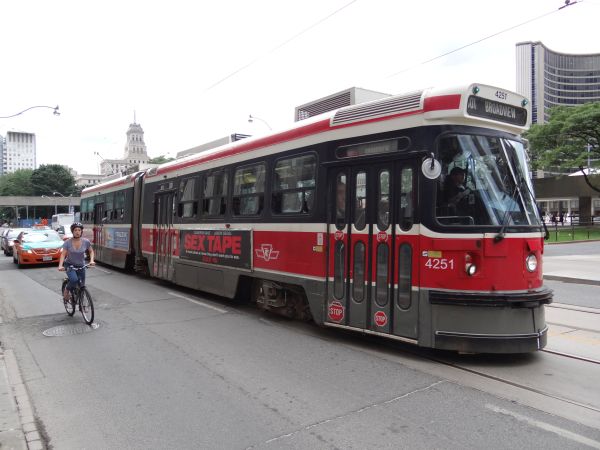
The city of Toronto has ten tram lines, which the locals call "streetcars" rather than trams. The network is fairly large and
has close to 700 tramstops and over half a million passengers on an average workday. The network is run by the TTC, Toronto Transit Commission,
the equivalent of European city or community owned transit agencies. The whole system is still fairly short: length of all the lines
together is a modest 83 km. The technology used is old-fashioned also. Trams take their power from old-fashioned trolley poles like
almost nowhere else in the world any more, except maybe in the former Soviet Union. The trolley wires are electrified with 600V DC.
At the time when these pictures were taken, in 2014, Toronto still had no modern trams, but today the busiest lines are operated by
otherwise quite up to date Bombardier Flexity trams, except for the totally outdated trolley pole system still used. Before the new
Flexity trams could be taken into use (They were late, as usual), Toronto was in real trouble as the existing trams of the types
CLRV/ALRV were all at least 30 years old and new capacity was not available.
This tram is of the type ALRV. 52 trams were built 1987-89. It's a 23,2 m long traditional, high-floor tram (entry is 4 steps high from
street level). It was also totally missing any kind of an aircondionining system, so technically it's fair to say that these trams,
even when they were new in the late 1980s, they represented the technology of European 1960s or early 1970s tram wagons.
Picture from Toronto King street 1.7.2014 by Ilkka Siissalo.
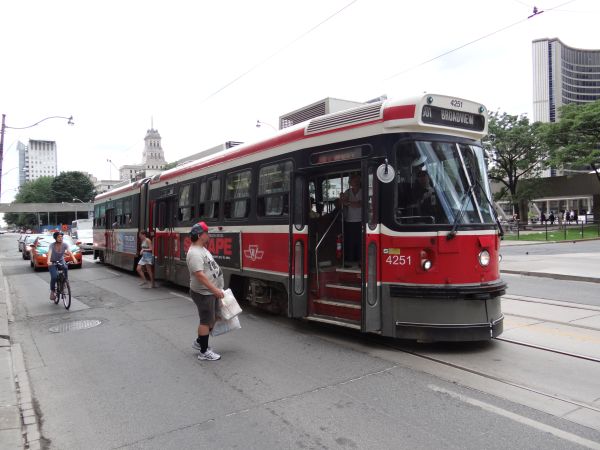
This is absolutely ridiculous in a modern, westerrn city like Toronto. This is Toronto's idea of a "low-foor" tram. And no
aircondioning.
Picture of an ALRV tram from Toronto King street 1.7.2014 by Ilkka Siissalo.

This is a CLRV tram, similar to the ALRV shown above, but with no articulated joint. CLRV stands for Canadian Light Rail Vehicle.
Besides being small and lacking airconditioning (except for just one CLRV tram which got air conditioning as a trial), these trams
were also not reliable during harsh winter months in temperatures below -20C. Today these ALRV/CLRV trams are kept only as a reserve
for peak hour services in case there would be a shortage of the new Bombardier Flexity Outlook trams. Note the "aircondionting" =
a couple of small, opened windows :-)
Picture from Toronto King street 2.7.2014 by Ilkka Siissalo.
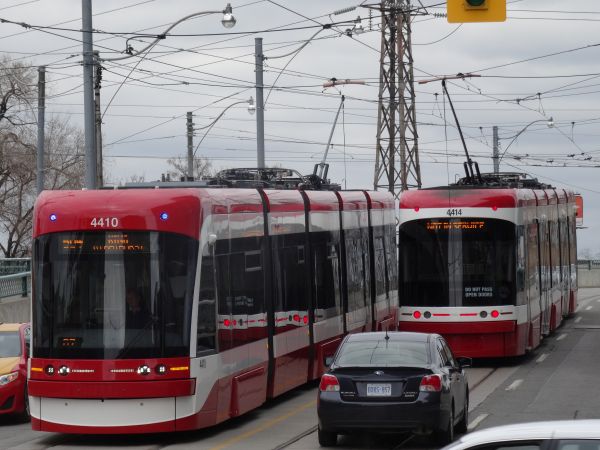
These are now the modern trams that have replaced the CLRV/ALRV trams shown above. These are Bombardier Flexity Outlook trams.
Note that they have on their roofs not only the old fashioned trolley poles, which they are still using in this picture, but
also normal, modern pantographs. The whole tram network of Toronto is undergoing a transition since 2008 to allow the use of
modern pantographs instead of clumsy, old trolley poles. These trams are also all low-floor, have proper aircondioning and all
the other amenities that a modern tram user expects in any western town.
Public domain picture from the corner of River and King streets in Toronto by the Wikipedia user "booledozer" 2.5.2016.
Metro (="subway") of Toronto

The Toronto metro or "subway" as the locals call it, serves Toronto and the neighbouring city of Vaughan in Ontario.
It's operated by the TTC, Toronto Transit Commission, which is the same operator that takes care of the Toronto trams
and the local buses. There are four metro lines plus two under construction. There are today 75 metro stations in use
and 1,6 million people use the Toronto metro on an average workday. Metro trains are classified as "heavy rail stock",
"light metro stock" and "light rail stock".
This is one of the so called Toronto rocket metro trains named according to the football (soccer) club of Toronto Rockets.
These trains are used on lines 1,2 and 4. They are so called Toronto-gauge trains with a gauge width 60mm wider than the
international standard gauge of 1435 mm, meaning their gauge width is 1495 mm. They use 600 V DC from a third rail.
Picture from the St.Patrick metro station in Toronto 8.7.2014 by Ilkka Siissalo.
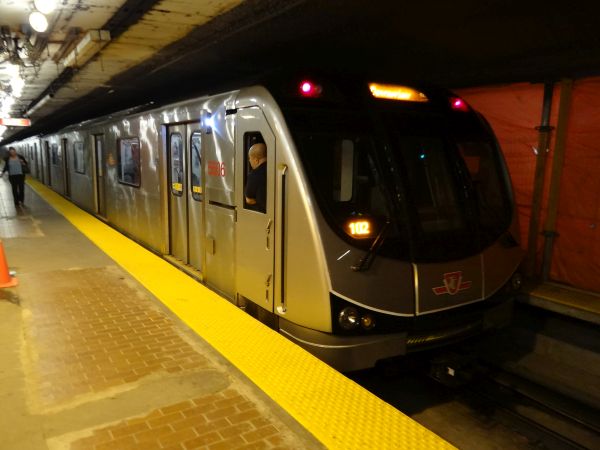
Though slightly different than the train shown above, this on is still one of the so called Toronto rockets trains.
This one no.5606 was built by Wilson in 2012. These trains were built in altogether 83 different series, each consisting of
typically 6 trains. There are minor differences between the series. This one is from series no.23 made by Wilson.
Picture from the St.Patrick metro station in Toronto 8.7.2014 by Ilkka Siissalo.
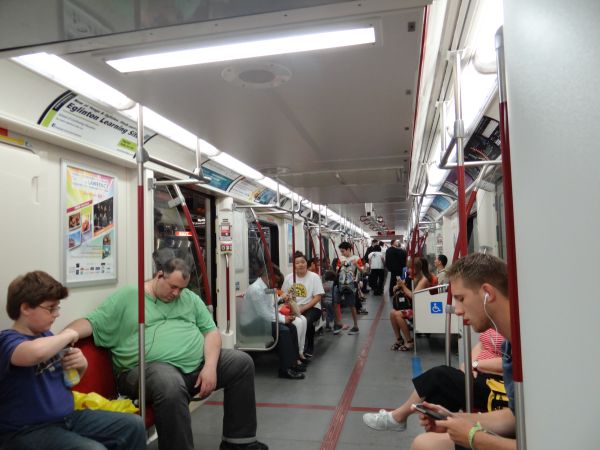
Inside view of a Toronto rocket class train.
Picture from Toronto 8.7.2014 by Ilkka Siissalo.

This is an older, so called T-series metro train arriving here at the station of Yonge. T-series, also called T1-series, was produced
1995.2001. 372 trains of this type were built. They are two-car fixed pairs. Each train has 66 seats.
Picture from Toronto Yonge station 10.7.2014 by Ilkka Siissalo.
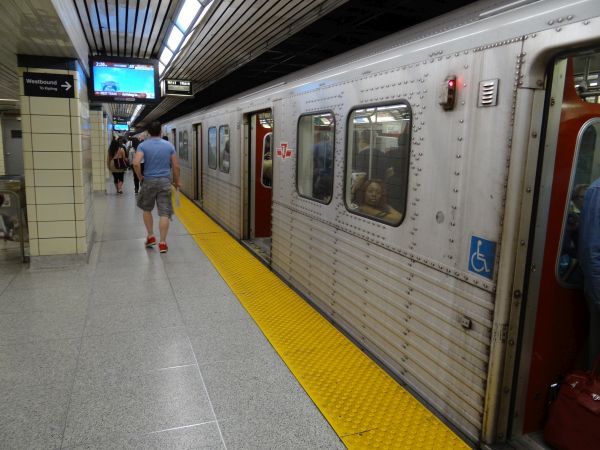
Outside view of a T1 series train.
Picture from Toronto Yonge station 10.7.2014 by Ilkka Siissalo.
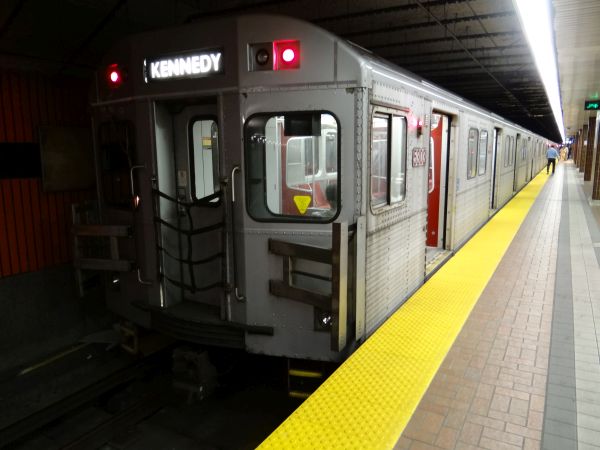
A bit better picture of a T1 class metro train at its terminal station Kennedy.
Picture from Toronto Kennedy station 10.7.2014 by Ilkka Siissalo.

This is one of the so called S series or "light metro stock" trains used on the line 3 Scarborough.
These trains start from the Kennedy station which is the endpoint of the normal metro line. These metro
trains consist of so called married pair sets and are not compatible with the other metro trains in Toronto area.
They could be run unmanned, but ttc has decided to have one person always on board. Their line is a little
over 6 km long system, entirely in the suburbs. These trains were built by Urban Transportation Development
Corporation 1983-86 and they have been refurbished in 2015-2016. 28 trains or pairs were built. Their electric system
is a quite complicated five-rail system using 600 V DC. Current collection is via induction.
Picture from Toronto Kennedy station 10.7.2014 by Ilkka Siissalo.
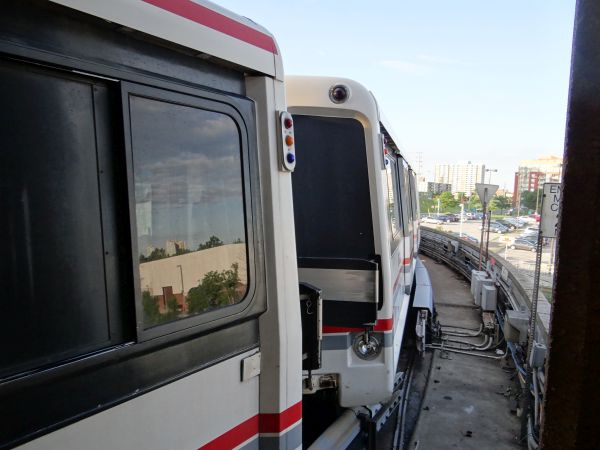
Scarborough line S series light metro train is turning in its loop by the Kennedy station. This reveals a part of the
complexity of its five-rail technology.
Picture from Toronto Kennedy station 10.7.2014 by Ilkka Siissalo.

The same S series light metro as above. Here you can see all of its five different rails.
Picture from Toronto Kennedy station 10.7.2014 by Ilkka Siissalo.

